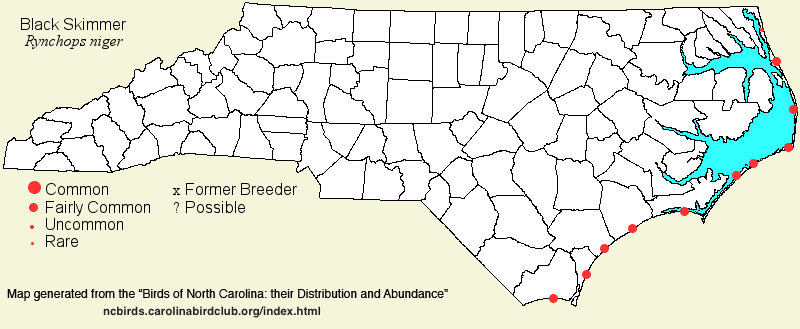 |  |
|
Black Skimmer - Rynchops niger LARIDAE Members: | Search Common: Search Scientific: |
|
|
|||||||
| General Comments | Though no other bird in North America looks like, forages like, and is related to the Black Skimmer, this species is closely allied in many ways with tern species. Skimmers are strictly coastal, and they essentially always nest amid colonies of Common and Gull-billed terns, and also often with Least Terns. These birds nest on open sand flats, typically on barrier islands or on dredge islands; like them, populations along the Atlantic Coast are in decline. As with most other terns, occurrences inland are almost always storm-related, and there are no mountain records as yet. Skimmers feed both diurnally and nocturnally, and in winter feed almost strictly at night, remaining in tight roosting flocks on sandbars during the day. Foraging occurs mostly in calm tidal waters, of estuaries and sounds, by dropping the lower mandible into the water and snapping the bill closed upon contact with a fish. | ||||||
| Breeding Status | Breeder | ||||||
| NC BRC List | Definitive | ||||||
| State Status | SC | ||||||
| U.S. Status | |||||||
| State Rank | S2B,S3N | ||||||
| Global Rank | G5 | ||||||
| Coastal Plain | Permanent resident (breeding), with migratory movements, along the coast. Fairly common (to formerly common), but slowly declining, along the entire coast in the warmer months -- more numerous along the southern coast (where can be common at times). In winter, uncommon to locally fairly common along the southern coast (mainly New Hanover and Brunswick); uncommon north to Carteret, but rare farther northward (and normally absent by midwinter). In the Tidewater zone, rare to uncommon during the warmer months, mainly at brackish waters; scarce to absent in winter. Farther inland, only four records, from Wayne: 1 on 22 Jul 1963, 2 in a flooded field on 24 Dec 1998 [Chat 63:149 link] -- a remarkable record for the date, and 1 on 6 Sep 2008; and 1 at Buckhorn Reservoir (Wilson), on 1 Sep 2006. Peak counts: 6,500, Morehead City, 9 Oct 1972; 4,000, Oregon Inlet, 3 Oct 1971. A tally of 1,500 at Mason Inlet (New Hanover) on 16 Nov 2013 is apparently the first 4-digit state count since the 1970's. | ||||||
| Piedmont | Storm-related visitor, to lakes and reservoirs; very rare, with 10 records, nearly all from the eastern and southern parts of the province. All are between 30 Aug and 7 Oct, with the exception of 1 at Jordan Lake on 23 Jun 1984, and one at Lake Hickory (Catawba), 13 Jun 2020. Peak counts: 27, Shelby, 22 Sep 1989 (after Hurricane Hugo); 6, Jordan Lake, 6-7 Sep 1996 (after Hurricane Fran). | ||||||
| Mountains | No records. | ||||||
| Finding Tips |
The species is usually seen on a day of coastal birding from Apr into Oct, though numbers are seldom large except at breeding colonies or in fall roosts. *** | ||||||
| Attribution | LeGrand[2023-03-14], LeGrand[2020-10-20], LeGrand[2019-04-19] | ||||||
| NC Map Map depicts all counties with a report (transient or resident) for the species. | Click on county for list of all known species. |
| NC Breeding Season Map Map depicts assumed breeding season abundance for the species. |  |